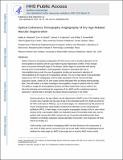Optical Coherence Tomography Angiography of Dry Age-Related Macular Degeneration
Author(s)
Waheed, Nadia K.; Moult, Eric Michael; Fujimoto, James G; Rosenfeld, Philip J.
DownloadAccepted version (656.3Kb)
Terms of use
Metadata
Show full item recordAbstract
Optical coherence tomography angiography (OCTA) can be used to visualize alterations in the choriocapillaris of patients with dry age-related macular degeneration (AMD). These changes seem to be present during all stages of the disease. Earlier stages are associated with patchy thinning of the choriocapillaris, while geographic atrophy is associated with loss of choriocapillaris lying under the area of geographic atrophy and asymmetric alteration of choriocapillaris at the margins of the geographic atrophy. The use of high-speed, long-wave-length swept-source OCT for angiography, with its better penetration into the choroid and high acquisition speeds, enable OCTA with scaled slowest detectable flow and fastest distinguishable flow. This will enable us to better investigate choriocapillaris changes in patients with dry AMD. The ability to image the choriocapillaris structure and flow impairments may be useful in the future for detecting and monitoring the progression of dry AMD and for monitoring treatment responses in clinical trials to therapies that target disease progression in dry AMD.
Date issued
2016Department
Massachusetts Institute of Technology. Department of Electrical Engineering and Computer Science; Massachusetts Institute of Technology. Research Laboratory of Electronics; Massachusetts Institute of Technology. Institute for Medical Engineering & ScienceJournal
OCT Angiography in Retinal and Macular Diseases
Publisher
S. Karger AG
Citation
Waheed, N. K. et al. "Optical Coherence Tomography Angiography of Dry Age-Related Macular Degeneration et al." OCT Angiography in Retinal and Macular Diseases 56 (2016): 91-100 © 2016 S. Karger AG
Version: Author's final manuscript
ISBN
9783318058291
9783318058307
ISSN
0250-3751
1662-2790